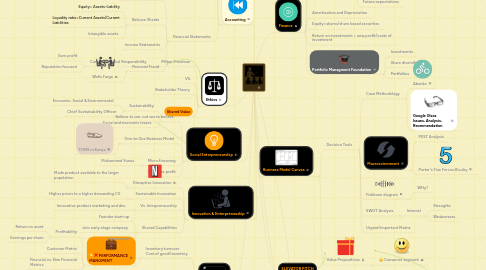
1. Ethics
1.1. Milton Friedman
1.1.1. Corporate Social Responsibility
1.1.1.1. Earn profit
1.1.1.2. Reputation focused
1.2. VS.
1.3. Stakeholder Theory
1.4. Shared Value
1.4.1. Sustainability
1.4.1.1. Economic, Social & Environmental
1.4.1.2. Chief Sustainability Officer
1.4.2. Social and economic issues
2. Social Enterpreneurship
2.1. Believe to see, not see to believe
2.2. One-to One Business Model
2.2.1. TOMS in Kenya
2.3. Micro financing
2.3.1. Muhammed Yunus
2.4. Still Make profit
3. Operations
3.1. Inventory turnover Cost of good/inventory
3.1.1. PERFORMANCE MANGMENT
3.1.1.1. Profitability
3.1.1.1.1. Return on asset
3.1.1.1.2. Earnings per share
3.1.1.2. Customer Metric
3.1.1.3. Financial vs. Non Financial Metrics
3.1.1.4. Quantitative vs. Qualitative
3.2. Direct Model
3.3. Virtual integration
3.3.1. "Power of Integration" Dell
3.4. Vertical Vs, Horizontal Integration
4. Innovation & Enterpreneuship
4.1. Disruptive Innovation
4.1.1. Made product available to the larger population
4.2. Sustainable Innovation
4.2.1. Higher prices to a higher demanding CS
4.3. Vs. Intrapreneurship
4.3.1. Innovative product marketing and dev.
4.4. Shared Capabilities
4.4.1. Founder start-up
4.4.2. Join early stage company
4.4.3. Intrapreneur
5. Accounting
5.1. Financial
5.1.1. Company Net Income
5.1.2. External Stakeholders
5.2. Managerial
5.2.1. Internal Managment
5.2.2. Product Income
5.2.3. Break-even & Target Profit
5.3. Financial Statements
5.3.1. Cash Flow Statements
5.3.2. Balance Sheets
5.3.2.1. Equity= Assets-Liability
5.3.2.2. Liquidity ratio=Current Assets/Current Liabilities
5.3.2.3. Intangible assets
5.3.3. Income Statements
5.3.4. Financial Fraud
5.3.4.1. Wells Fargo
6. Blog: Samsung vs. Apple
7. Strategy
7.1. Competitive Strategy
7.1.1. Strategic Positioning
7.1.1.1. POP
7.1.1.2. POD
7.2. Operational Effectivness
7.2.1. Performing activities better than the competition
7.3. Porter's Generic Strategies
7.4. Transient Advantage
7.4.1. Continous change
8. Finance
8.1. Financial Markets
8.1.1. Capital
8.1.2. Primary vs. Secondary
8.2. Time Value of Money
8.2.1. Inflation + default risk
8.2.2. PV=FV/(1+i)^n
8.2.3. Future expectations
8.3. Amortization and Depreciation
8.4. Equity=shares/share based securities
8.5. Return on investments = new profit/costs of investment
8.6. Portfolio Managment Foundation
8.6.1. Investments
8.6.2. Share diversification
8.6.3. Portfoliios
9. Business Model Canvas
9.1. Decision Tools
9.1.1. Case Methodology
9.1.1.1. Abanke
9.1.1.2. Google Glass Issues, Analysis, Reommendation
9.1.2. Macroevironment
9.1.2.1. PEST Analysis
9.1.2.2. Porter's Five Forces:Rivalry
9.1.3. Fishbone diagram
9.1.3.1. WHy?
9.1.4. SWOT Analysis
9.1.4.1. Internal
9.1.4.1.1. Strengths
9.1.4.1.2. Weaknesses
9.1.5. Urgent/important Matrix
9.2. Value Propositions
9.2.1. Consumer segment
